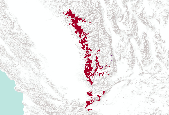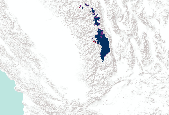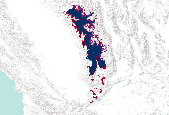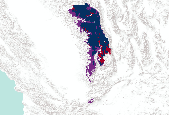Filters: Tags: scenario (X)
275 results (13ms)|
Filters
Date Range
Extensions (Less) Types (Less)
Contacts (Less)
Categories (Less) Tag Types
|

The Nature Conservancy (TNC) has derived climate suitability forecasts for most species of trees and shrubs considered to be ecological dominants of terrestrial Californian habitat types. Our plant projections are compiled as decision support tools to help Conservancy project staff, as well as our external partners, develop the necessary plans, priorities and strategies to successfully adapt to uncertain changes in future climate. In the recently completed Southern Sierra Partnership's 2010 Climate-Adapted Conservation Plan for the Southern Sierra Nevada and Tehachapi Mountains, species and habitat forecasts shown here informed the development of a regional conservation design that explicitly incorporates long-term...

The Nature Conservancy (TNC) has derived climate suitability forecasts for most species of trees and shrubs considered to be ecological dominants of terrestrial Californian habitat types. Our plant projections are compiled as decision support tools to help Conservancy project staff, as well as our external partners, develop the necessary plans, priorities and strategies to successfully adapt to uncertain changes in future climate. In the recently completed Southern Sierra Partnership's 2010 Climate-Adapted Conservation Plan for the Southern Sierra Nevada and Tehachapi Mountains, species and habitat forecasts shown here informed the development of a regional conservation design that explicitly incorporates long-term...

The Nature Conservancy (TNC) has derived climate suitability forecasts for most species of trees and shrubs considered to be ecological dominants of terrestrial Californian habitat types. Our plant projections are compiled as decision support tools to help Conservancy project staff, as well as our external partners, develop the necessary plans, priorities and strategies to successfully adapt to uncertain changes in future climate. In the recently completed Southern Sierra Partnership's 2010 Climate-Adapted Conservation Plan for the Southern Sierra Nevada and Tehachapi Mountains, species and habitat forecasts shown here informed the development of a regional conservation design that explicitly incorporates long-term...
The paper traces the manner in which an obligation came to be imposed on select industries, requiring them to take account of amenity, wildlife and outdoor-recreational interests in the course of preparing and carrying out developmental schemes. Under pressure from the relevant voluntary bodies, the statutory obligations, first imposed on hydro-electric power development, were generalized to cover 'whole' industries, and then, under the Countryside Acts of 1967-68, were extended to all State utilities. The recent privatization of those industries has provided a further pretext for extending and strengthening the 'amenity' clause. The approach has provided important insights into how industry itself might become...
Categories: Publication;
Types: Citation;
Tags: Alternative,
CO2 emissions,
Technology,
analysis,
approaches,
This dataset contains a projection of land use and land cover for the conterminous United States for the period 2001 - 2061. This projection used the USGS's LUCAS (Land Use and Carbon Scenario Simulator) model to project a business as usual scenario of land cover and land use change. By running the LUCAS model on the USGS's YETI high performance computer and parallelizing the computation, we ran 100 Monte Carlo simulations based on empirically observed rates of change at a relatively fine scale (270m). We sampled from multiple observed rates of change at the county level to introduce heterogeneity into the Monte Carlo simulations. Using this approach allowed the model to project different outcomes that were summarized...

This dataset represents presence of Jack Pine (Pinus banksiana) in Minnesota (USA) at year 50 (2045) from a single model run of LANDIS-II. The simulation assumed Intergovernmental Panel on Climate Change (IPCC) B2 emissions (moderate) and used the Hadley 3 global circulation model. Restoration harvest rates and intensities were simulated.

This dataset represents presence of Sugar Maple (Acer saccharum) in Minnesota (USA) at year 0 (2145) from a single model run of LANDIS-II. The simulation assumed Intergovernmental Panel on Climate Change (IPCC) B2 emissions (moderate) and used the Hadley 3 global circulation model. Contemporary harvest rates and intensities were simulated.

Ken Ferschweiler (CBI) used climate data from the PRISM group (Chris Daly, Oregon State University) at 4kmx4km spatial grain across the conterminous USA to generate a climatology or baseline. He then created future climate change scenarios using statistical downscaling and created anomalies from the Hadley CM3 General Circulation Model (GCM) run through the A2 emission scenario (SRES - special report on emission scenarios published in 2000). To run the MAPSS model (Neilson 1995), average monthly precipitation values were calculated for the period 2045-2060. This dataset shows the standard deviation of the annual precipitation for that period.

The Nature Conservancy (TNC) has derived climate suitability forecasts for most species of trees and shrubs considered to be ecological dominants of terrestrial Californian habitat types. Our plant projections are compiled as decision support tools to help Conservancy project staff, as well as our external partners, develop the necessary plans, priorities and strategies to successfully adapt to uncertain changes in future climate. In the recently completed Southern Sierra Partnership's 2010 Climate-Adapted Conservation Plan for the Southern Sierra Nevada and Tehachapi Mountains, species and habitat forecasts shown here informed the development of a regional conservation design that explicitly incorporates long-term...

The Nature Conservancy (TNC) has derived climate suitability forecasts for most species of trees and shrubs considered to be ecological dominants of terrestrial Californian habitat types. Our plant projections are compiled as decision support tools to help Conservancy project staff, as well as our external partners, develop the necessary plans, priorities and strategies to successfully adapt to uncertain changes in future climate. In the recently completed Southern Sierra Partnership's 2010 Climate-Adapted Conservation Plan for the Southern Sierra Nevada and Tehachapi Mountains, species and habitat forecasts shown here informed the development of a regional conservation design that explicitly incorporates long-term...

The Nature Conservancy (TNC) has derived climate suitability forecasts for most species of trees and shrubs considered to be ecological dominants of terrestrial Californian habitat types. Our plant projections are compiled as decision support tools to help Conservancy project staff, as well as our external partners, develop the necessary plans, priorities and strategies to successfully adapt to uncertain changes in future climate. In the recently completed Southern Sierra Partnership's 2010 Climate-Adapted Conservation Plan for the Southern Sierra Nevada and Tehachapi Mountains, species and habitat forecasts shown here informed the development of a regional conservation design that explicitly incorporates long-term...

The Nature Conservancy (TNC) has derived climate suitability forecasts for most species of trees and shrubs considered to be ecological dominants of terrestrial Californian habitat types. Our plant projections are compiled as decision support tools to help Conservancy project staff, as well as our external partners, develop the necessary plans, priorities and strategies to successfully adapt to uncertain changes in future climate. In the recently completed Southern Sierra Partnership's 2010 Climate-Adapted Conservation Plan for the Southern Sierra Nevada and Tehachapi Mountains, species and habitat forecasts shown here informed the development of a regional conservation design that explicitly incorporates long-term...

The Nature Conservancy (TNC) has derived climate suitability forecasts for most species of trees and shrubs considered to be ecological dominants of terrestrial Californian habitat types. Our plant projections are compiled as decision support tools to help Conservancy project staff, as well as our external partners, develop the necessary plans, priorities and strategies to successfully adapt to uncertain changes in future climate. In the recently completed Southern Sierra Partnership's 2010 Climate-Adapted Conservation Plan for the Southern Sierra Nevada and Tehachapi Mountains, species and habitat forecasts shown here informed the development of a regional conservation design that explicitly incorporates long-term...

The Nature Conservancy (TNC) has derived climate suitability forecasts for most species of trees and shrubs considered to be ecological dominants of terrestrial Californian habitat types. Our plant projections are compiled as decision support tools to help Conservancy project staff, as well as our external partners, develop the necessary plans, priorities and strategies to successfully adapt to uncertain changes in future climate. In the recently completed Southern Sierra Partnership's 2010 Climate-Adapted Conservation Plan for the Southern Sierra Nevada and Tehachapi Mountains, species and habitat forecasts shown here informed the development of a regional conservation design that explicitly incorporates long-term...

The Nature Conservancy (TNC) has derived climate suitability forecasts for most species of trees and shrubs considered to be ecological dominants of terrestrial Californian habitat types. Our plant projections are compiled as decision support tools to help Conservancy project staff, as well as our external partners, develop the necessary plans, priorities and strategies to successfully adapt to uncertain changes in future climate. In the recently completed Southern Sierra Partnership's 2010 Climate-Adapted Conservation Plan for the Southern Sierra Nevada and Tehachapi Mountains, species and habitat forecasts shown here informed the development of a regional conservation design that explicitly incorporates long-term...

This dataset represents presence of white pine (Pinus strobus) at year 100 (2095) from a single model run of LANDIS-II. The simulation assumed Intergovernmental Panel on Climate Change (IPCC) B2 emissions (moderate) and used the Hadley 3 global circulation model. Contemporary harvest rates and intensities were simulated.
The Vista tool is used to create a Scenario of the CAs affecting the North American Warm Desert Lower Montane Riparian Woodland, Shrubland and Stream CE and applies user-input Landscape Condition Model (LCM) scores to generate ESAs for each of the CEs. The LCM consists of Site Impact scores and impact Distances for each CA category. Site Impact scores are a value between 0 and 1 representing the impact of the CA on the relevant CEs. A score close to 1 indicates negligible or no impact from that CA. A score close to 0 indicates the highest possible impact, e.g. an interstate highway that makes the area in which it occurs completely unsuitable for the CE. Distances are set in meters and extend the impact of the CA...
The Vista tool is used to create a Scenario of the CAs affecting the Madrean Encinal CE and applies user-input Landscape Condition Model (LCM) scores to generate ESAs for each of the CEs. The LCM consists of Site Impact scores and impact Distances for each CA category. Site Impact scores are a value between 0 and 1 representing the impact of the CA on the relevant CEs. A score close to 1 indicates negligible or no impact from that CA. A score close to 0 indicates the highest possible impact, e.g. an interstate highway that makes the area in which it occurs completely unsuitable for the CE. Distances are set in meters and extend the impact of the CA from the footprint out for the specified distance, declining along...
The Vista tool is used to create a Scenario of the habitat quality CAs affecting the North American Warm Desert Riparian Woodland, Shrubland, Mesquite Bosque and Stream CE and applies user-input Landscape Condition Model (LCM) scores to generate ESAs for each of the CEs. The LCM consists of Site Impact scores and impact Distances for each CA category. Site Impact scores are a value between 0 and 1 representing the impact of the CA on the relevant CEs. A score close to 1 indicates negligible or no impact from that CA. A score close to 0 indicates the highest possible impact, e.g. an interstate highway that makes the area in which it occurs completely unsuitable for the CE. Distances are set in meters and extend the...
The Vista tool is used to create a Scenario of CAs affecting the Terrestrial Desert Scrub Lifezone Distribution CE and applies user-input Landscape Condition Model (LCM) scores to generate an Ecological Integrity Assessment (EIA) for the CE. The LCM consists of Site Impact scores and impact Distances for each CA category. Site Impact scores are a value between 0 and 1 representing the impact of the CA on the relevant CEs. A score close to 1 indicates negligible or no impact from that CA. A score close to 0 indicates the highest possible impact, e.g. an interstate highway that makes the area in which it occurs completely unsuitable for the CE. Distances are set in meters and extend the impact of the CA from the footprint...
|

|